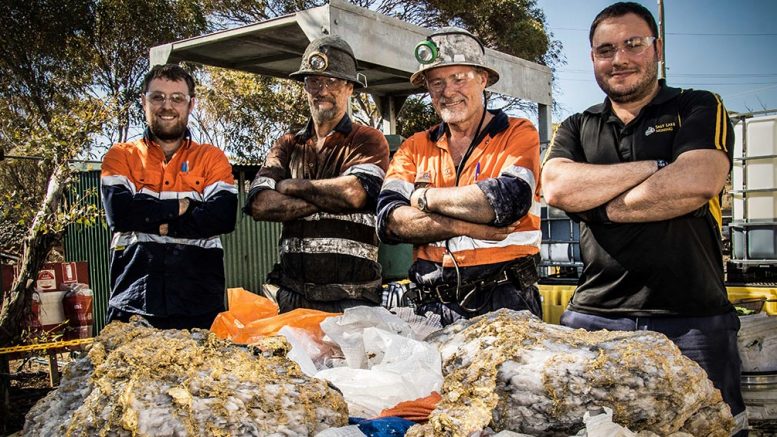RNC Minerals (TSX: RNC) has found a 95-kilogram specimen of rock containing 2,400 oz. gold worth an estimated $4 million and another 65-kilogram specimen with an estimated 1,600 oz. gold valued at $2.6 million at its Beta Hunt mine in Australia.
The rare gold-encrusted rocks were found on level 15 of the mine and could rank among the largest ever discovered.
Over the last week, RNC has produced 9,250 oz. gold from a 44-cubic-metre cut — or 130 tonnes — from the mine’s level 15, worth $15 million in total at US$1,200 per oz. gold.
“It’s a once-in-a-lifetime find,” Mark Selby, RNC’s president and CEO, told analysts and investors on a conference call. “It’s one of the most outstanding discoveries not only in Western Australia, but globally.
“More than 9,000 oz. from a small area confirms the significance of these high-grade structures,” Selby continued. “This sediment structure has been well known and documented through geological work in a broader area, and [there is] also potential for literally kilometres of strike length for high-grade structures to be discovered.”
In March, the company announced it was looking for a buyer for the mine so that it could focus on its nickel-cobalt Dumont project, which it says has the world’s largest undeveloped reserves of nickel and second-largest undeveloped reserves of cobalt.
In July, RNC said it had selected a preferred bidder and granted it exclusivity to complete final due diligence. But with the discovery, management says, it will reconsider all alternatives, including a sale, but is no longer in exclusive discussions with the preferred bidder.
“This discovery and additional cash helps on multiple fronts, transforms our balance sheet and takes away any cash flow pressure,” Selby said. “We’ll have generated significant cash flow this quarter from this high-grade material and it’s still open in a number of directions. The key thing is, we’re going to spend some time probing along the structure to try to understand how much gold is there, and from there, craft a go-forward plan … as we look for alternatives like selling it, or spinning it out, and getting cash Beta Hunt needs for exploration.”
The mine, 600 km from Perth in Kambalda, hosts nickel and gold resources in adjacent discrete mineralized zones. Gold mineralization occurs in the Lunnon Basalt, which is the footwall to the nickel-bearing ultramafics, and is characterized by intense albite, carbonate and chlorite alteration, with a halo of biotite-pyrite alteration. (The nickel is hosted mainly by talc-carbonate and serpentine-altered ultramafic rocks, and is typically pyrrhotite-pentlandite-pyrite-chalcopyrite.)
RNC says it is the first owner to focus on drilling deeper in the Lunnon Basalt in its search for gold, and the first owner to discover and mine gold from new coarse gold entirely within the Lunnon Basalt. Previous bonanza grades at Beta Hunt were associated with the nickel- and sulphide-bearing contact between the Lunnon Basalt and the overlying Kambalda Komatiite, where RNC and previous operators focused on nickel mining.
Based on diamond drilling and underground mapping, there are two or more Lunnon sediment bands on a zone of narrow (less than 0.3 metre), strongly pyritic black shale horizons, 150 metres stratigraphically below the Lunnon Basalt-Kambalda Komatiite nickel contact.
The sediment horizon is interpreted by geologists as a zone of chemical interaction between the gold-bearing fluids and pyritic sulphides, which under the right conditions, allow large gold-crystal growth and high-grade gold deposition.
Kevin Small, RNC’s director of mining operations, noted on the conference call that there were other “spectacular” rock specimens that did not make it into the latest press release that are being stored for future sale.
“In four days, we’ve proved two months average gold production, which is fairly significant,” he said.
“Is the gold continuous?” Small mused. “Only time will tell … but we’re definitely very excited about what’s going on in the structure, and we’re just in the infancy of discovering this mineralization. So we have years and years of mining to see how deep these structures go, and what is the economic value of them.
“The grades are increasing with depth,” he added. “Potentially it’s a one-off, but mother nature has a number of surprises, and this is definitely one of them.”
Beta Hunt produced 13,320 gold oz. in the second quarter of the year — a 60% increase from the same quarter in 2017.
The mined grade for the quarter improved to 3.14 grams gold per tonne, including the specimen gold mining on level 15, which contributed 1,445 oz. production for the quarter.


Be the first to comment on "RNC finds multimillion-dollar gold nuggets at Beta Hunt"